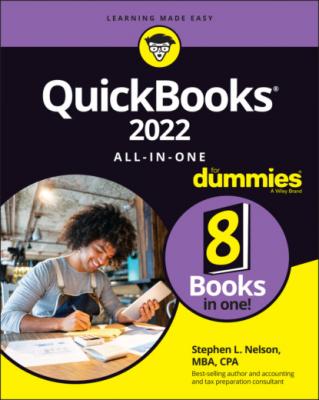QuickBooks 2022 All-in-One For Dummies. Stephen L. Nelson
Чтение книги онлайн.
Читать онлайн книгу QuickBooks 2022 All-in-One For Dummies - Stephen L. Nelson страница 31

| Account | Debit | Credit |
|---|---|---|
| Allowance for uncollectible | $100 | |
| Accounts receivable | $100 |
None of these entries is particularly tricky as long as you understand the logic — something that I hope I’ve illuminated for you in this discussion. If you do have trouble with these journal entries or with recording the economic events that they attempt to summarize, you may want to consult your CPA. Most likely, you’d record these same transactions (with different customers and amounts, of course) many, many times over the year. If you can get a bit of help or a template that shows you how to record these transactions, you should be able to record them yourself without any outside help.
Recording Accounts Payable Transactions
Within QuickBooks, you have the option of working with or without an accounts payable account. If you want to, you can record expenses when you write checks. This means that to have a complete list of all your expenses, you must have recorded checks that pay all your expenses. This approach works fine — and, in fact, is the approach that I’ve always used in my businesses.
QuickBooks also supports a more precise approach of recording expenses. By answering a few questions during the QuickBooks setup process, you can set up an accounts payable account, which is an account that tracks the amounts that you owe your vendors and other suppliers.
Recording a bill
When you use an accounts payable account, you enter the bills that you get from vendors when you receive them.
Table 3-5 shows the way this transaction is recorded. Journal Entry 5 automatically debits office-supplies expense for $1,000 and credits accounts payable for $1,000. QuickBooks would record this journal entry if you purchased $1,000 of office supplies and then entered that bill into the QuickBooks system.
TABLE 3-5 Journal Entry 5: Recording a Credit Purchase
| Account | Debit | Credit |
|---|---|---|
| Office supplies | $1,000 | |
| Accounts payable | $1,000 |
Paying a bill
When you later pay that bill, QuickBooks records Journal Entry 6, shown in Table 3-6. In Journal Entry 6, QuickBooks debits accounts payable for $1,000 and credits cash for $1,000. The net effect on accounts payable combining both the purchase and the payment is zero. That makes sense, right? The approach shown in journal entries 5 and 6 counts the amount that you owe some vendor or supplier as a liability — accounts payable — only while you owe the money.
TABLE 3-6 Journal Entry 6: Recording the Payment to Vendor
| Account | Debit | Credit |
|---|---|---|
| Accounts payable | $1,000 | |
| Cash | $1,000 |
When you record Journal Entry 6 in QuickBooks, you must supply the name of the account that gets debited. QuickBooks obviously knows which account to credit: the accounts payable account. But QuickBooks also has to know the expense or asset account to debit.
QuickBooks does need to know which cash account to credit when you pay an accounts payable amount. You identify this account when you write the check to pay the bill.
Taking some other accounts payable pointers
Let me make a couple of additional points about journal entries 5 and 6:
The accounts payable method is more accurate. The accounts payable method, which journal entries 5 and 6 show, is the best way to record your bills. The accounts payable method means that you record expenses when the expenses actually occur. As you may have already figured out, the accounts payable method is the mirror image of the accounts receivable approach described in the early paragraphs of this chapter. The accounts payable method, as you may intuit, delivers two big benefits: It keeps track of the amounts that you owe vendors and suppliers, and it recognizes expenses as they occur rather than when you pay them (which may be some time later).
Not every debit is for an expense. Journal Entry 5 shows the debit going to an office-supplies expense account. Many of the accounts payable that you record are amounts owed for expenses. Not every accounts payable transaction stems from incurring some expense, however. You may also need to record the purchase of an asset, such as a piece of equipment. In this case, the debit goes not to an expense account, but to an asset account. Except for this minor change, however, the transaction works the same way. I describe how fixed asset accounting works later in this chapter, in the “Accounting for Fixed Assets” section.
If you’re purchasing a $1,000 piece of equipment, the journal entry looks and works roughly the same way. When you record the purchase, QuickBooks debits the asset account for $1,000 and credits cash for $1,000. Again, this transaction gets recorded when you write the check to pay for the asset.
Inventory Accounting